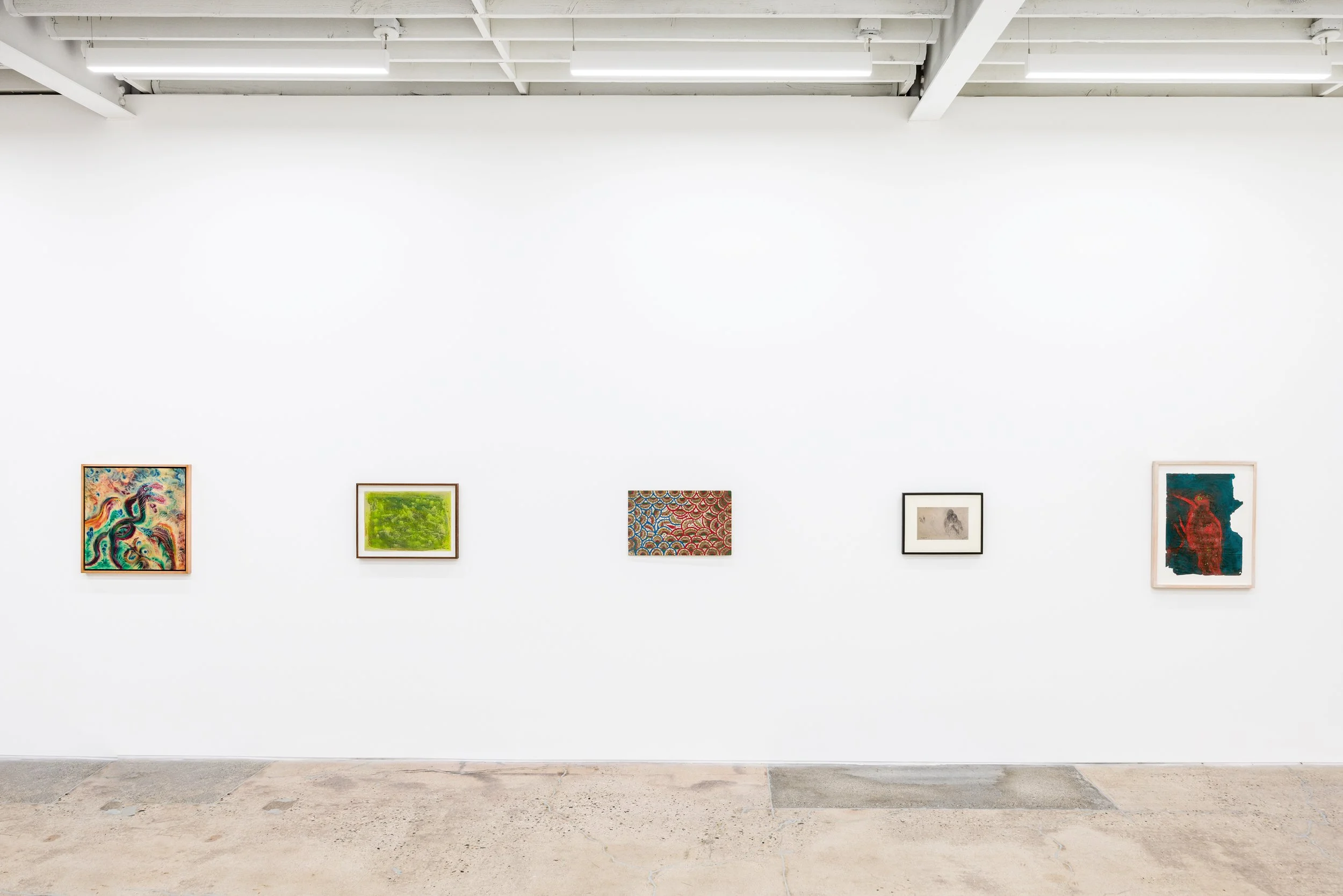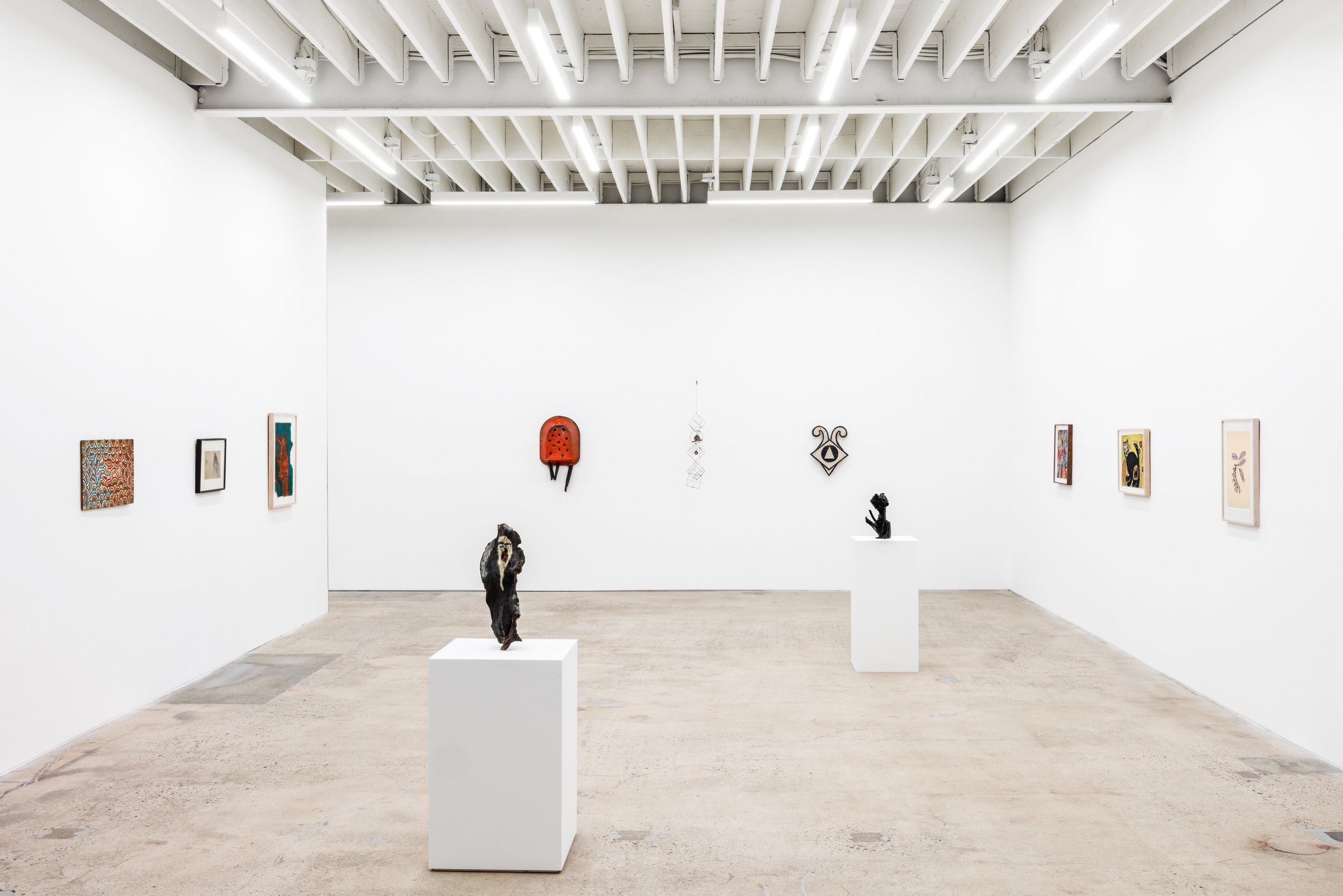Healing Machine
Curated by Hayley Barker and Scott Ogden
July 27 - September 7, 2024
-
Emery Blagdon (1907-1986) spent years filling a barn on his rural Nebraska property with delicate hanging mobiles, sculptures and paintings. Using wire, found objects, sheet metal and elemental compounds sourced from a local pharmacy, Blagdon believed his creations generated an electromagnetic energy with immense healing properties, referring to the project as a “healing machine”.
-
Hawkins Bolden (1914-2005) was left completely blind at the age of seven following an accident involving his twin brother, Monroe. In his later years, Bolden committed his life to creating scarecrow assemblages, crafted entirely by touch, to protect his beloved vegetable garden at his family home in Memphis, Tennessee.
-
Lily Gibeon (ca 1940s/1950s) was a patient at Friern Hospital in the UK, a large-scale psychiatric asylum outside of London. Sometime during the 1940s and 1950s, and under the care of her psychiatrist, Dr. A.C. Dalzell, Gibeon began creating whimsical paintings of cats, friends and other symbols of the outside world.
-
Ralph Griffin (1925-1992) was born in Burke County, Georgia to a cotton farmer, and he stayed on the farm until he was thirty. Griffin made his first root sculpture in 1978 when he found a piece of misshapen wood in Polar Root Branch, a small creek that ran behind his home. He continued to make these sculptures in the fifteen years after his retirement from a cookie factory, where he worked as a custodian. Griffin believed the roots had significant meaning and possessed what he called “deep feeling”.
-
Bessie Harvey (1929-1994) found solace in her deeply spiritual sculptures, made from roots and found objects, adorned with enamel paint, glitter, shells and beads. amidst her hardships as a mother of eleven children living in Georgia.
-
Ike Morgan (b. 1958) is a self-taught artist who resided at the Austin State Hospital from the age of 17 through 41. While at the hospital, he obsessively leaned into painting and drawing to occupy himself and utilized any materials that he could source or barter for. His imagery ranges from the portraits of the founding fathers and presidents, to birds and other wildlife observed and seen in books, and even to Yurtle the Turtle.
-
J.B. Murray (1908-1988) experienced hallucinations and visions from God, which led him to develop anxiety about evil surrounding him, especially after being left by his wife and children. Murray lived in a remote region of Georgia and began creating “protective devices”, which were highly symbolic paintings on found objects.
-
Melvin Edward Nelson (1908-1992) lived and worked as a recluse on his seventy-acre farm in Colton, Oregon. Nelson developed a highly unique form of scientific research in the form of abstract paintings created with handmade pigments, which he believed to possess traces of scientific intervention and supernatural occurrences.
-
Prophet Royal Robertson (1936-1997) experienced frequent visions, believing Mafia hit men and aliens were targeting him. He claimed to astrally project and time travel, leaving his body behind to record his travels when he returned. A recluse following his family’s exit, Robertson covered his home with apocalyptic paintings and signs that graphically illustrated the daily concerns that occupied his mind, both real and imagined. He considered his abstract symbols and imagery to be divine.
-
Janet Sobel (1894-1968) was born in Ukraine and emigrated to the United States in 1908. She returned to a childhood love of painting later in life and found rapid success In New York for her abstract paintings, which are thought to have inspired Pollock. Sobel came from a long line of female Spiritualists and mystics, and this infused all of her works and her creative vision at the core level.
-
Sarah Mary Taylor (1916-2000) was a self-taught artist born in Anding, Mississippi, who came to art and quilting late in life after retiring from many strenuous jobs. Her works stem from a long line of African American textile traditions passed down through her family, but more importantly highlight her unique existence and personality, and also the weight of a hard life lived.
-
Eugene Von Bruenchenhein (1910-1984) lived and worked in Wisconsin, where he began painting while working at a bakery. Among his many creative pursuits, which included assembling chicken bones into miniature thrones, Von Breuinchenhein created a process of painting on found boards using vibrant oil colors applied and then blurred and shaped with combs, quills, and bakery tools to divine their images.
-
Helen Butler Wells (1854-1940) was an American medium for more than 25 years. Her talents evolved to include automatic writing and drawing, which she completed under the artistic influence of a spirit guide called Eswald. Her works were all continuous lines and were completed in a single sitting.
-
Anna Zemánková (1908-1986) is one of fourteen artists featured in our Los Angeles exhibition, Healing Machine. Zemánková was born in Moravia, now part of Czech Republic, and later moved her family to Prague. Always artistic, she began drawing and painting in earnest around 1960 at the urging of her sons who sought to pull her out of depression and bouts of severe mood swings. Her otherworldly images of fantastical plants and imagined botanical forms were executed in a highly-stylized and intuitive manner that feels surreal and mystical.
Healing Machine unites fourteen self-taught artists whose primary intentions for creating their works superseded any desire to make “art.” Their unbridled and passionate pursuits varied, but they all shared a fervent dedication to realizing their goals. For some, this was communion with Nature, extraterrestrials or spiritual realms; and for others it was attempting to heal themselves and the world through their inventions.
Unaware that he was an artist, Emery Blagdon devoted his entire life to constructing a machine capable of healing anyone within its presence, a project that inherently required his absolute certainty that this technology was possible. This same level of conviction infuses the transcriptions made by J.B. Murray, who firmly believed God was speaking through his hands, and the automatic drawings of Helen Butler Wells, a Spiritualist and medium who asserted that a spirit named Eswald guided her pencil across paper. In these situations where human ingenuity and creativity are forged in circumstances beyond the typical scope of art history and its adjoined market, entirely new forms of artistic expression emerge.
The unique narratives, life situations and visionary ideas that fuel the inceptions of self-taught artists directly reflect in their works, which is part of what makes their creations so deeply compelling and revered. This exhibition seeks to provide a snapshot of the deeply idiosyncratic personal visions and psyches of these artists, and the works presented manifest a symbolic healing machine that suggests anything is possible when you believe strongly enough.







